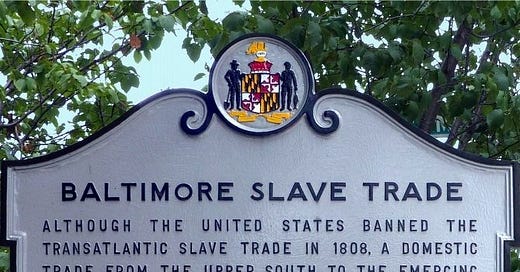Hard History at Baltimore's Harborplace
Baltimore Sun readers urge a reckoning with the city’s history of slave trading
We may not have many statues of the enslaved — we may not have anywhere near enough letters and portraits and personal records for the millions who lived and died in bondage — but they were living, breathing individuals nonetheless, as real to the world as the men and women we put on pedestals. — Jamelle Bouie
What is the “unique history” of Baltimore that a planned for revitalization of the city’s Harborplace should reflect? Baltimore Sun readers took up just that question in response to the paper’s April 7 editorial, “Reinventing Harborplace: Baltimore Needs a Safe, Vibrant, Inclusive and Fun Place to Gather.” Their suggestions included recalling the city’s difficult past.
Less than two months ago, in February, the Sun’s Editorial Board began its accounting for how racism fueled the paper’s past offenses, earning it the “distrust” of many Black Baltimoreans. Among the Sun’s new commitments: “Reflecting and promoting the experiences of the full spectrum of our population, across racial, religous, economic, sexual and social boundaries.”
Only weeks later, readers responded when the Sun’s recounting of the harbor’s “unique history” read more like a promotional brochure than a full accounting of the past. The Editorial Board called for a history at Harborplace that would “celebrate its working class roots and its small town vibe, its love of steamed crabs, and its place as a Mid-Atlantic crossroads, home of the first commercial railroad in the U.S. and namesake of the Baltimore Clipper, the fast-moving sailing ships of the late 18th century.”
Readers caught an important omission: The city’s domestic slave trade. A letter to the editor quoted from the paper’s own July 12, 2000 editorial: “Between 1815 and 1860, traders in Baltimore made the port one of the leading disembarkation points for ships carrying slaves to New Orleans and other ports in the deep South.” Another wrote: “An accurate reflection of Baltimore’s unique history might also include a memorial to victims of the Baltimore slave trade, for which Harborplace or the Inner Harbor area would be an ideal site.”
At Hard Histories, we hosted Dr. Jennie Williams who spoke with us about her research into Baltimore’s coastal slave trade to the markets of New Orleans. Since we last spoke with her, Dr. Williams launched a database, Oceans of Kinfolk, featured by New York Times columnist Jamelle Bouie in “We Still Can’t See American Slavery for What It Was.” Dr. Williams accounts for the statistical facts and makes possible our reckoning with the human cost of Baltimore’s domestic slave trade.
The time for forgetting Baltimore’s role in the slave trade is behind us. Out ahead are frank atonements and reckonings with the city’s role in the market for human bondage. Have a closer look at how other localities have memorialized their connections to slavery’s past over at Dr. Renée Ater’s “Contemporary Monuments to the Slave Past.” One striking example comes from France’s slave trading port of Nantes.
While some Confederate monuments in our city have come down in recent years, readers of the Sun are calling for the putting up of a new memorial to the victims of the slave trade. That would be a statement about our past. More powerful is what it might say about our future.
— MSJ
Photo credit: hmdb.org




